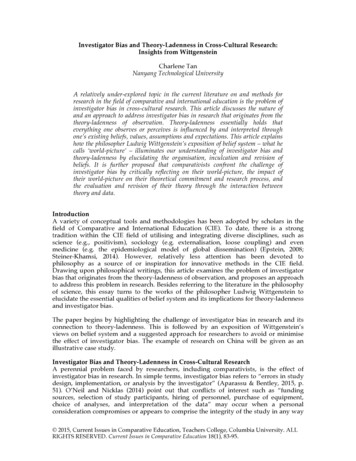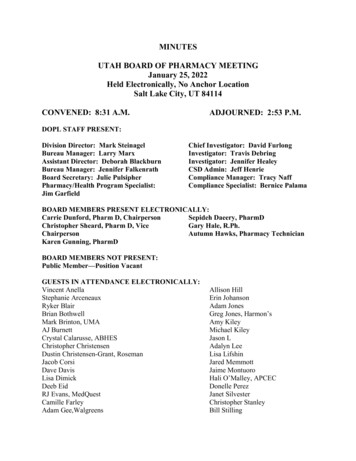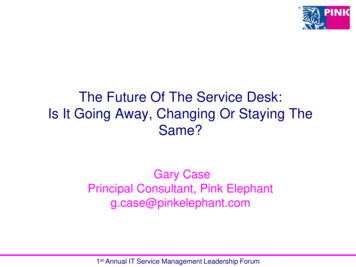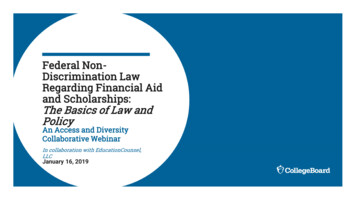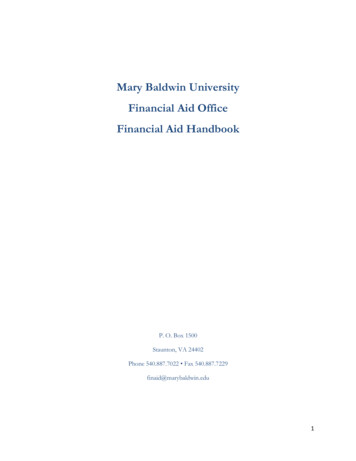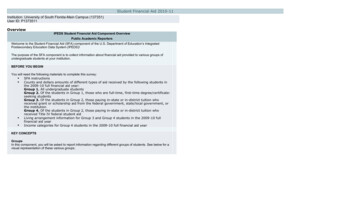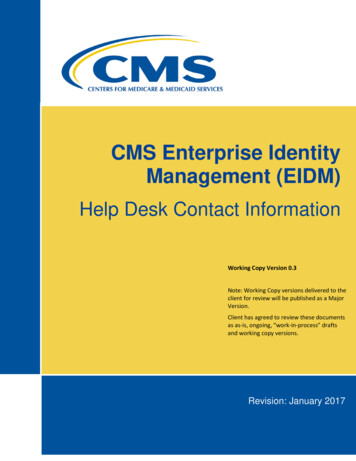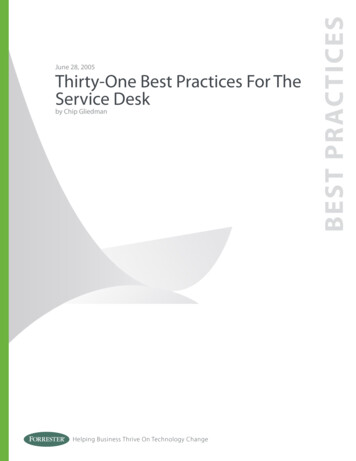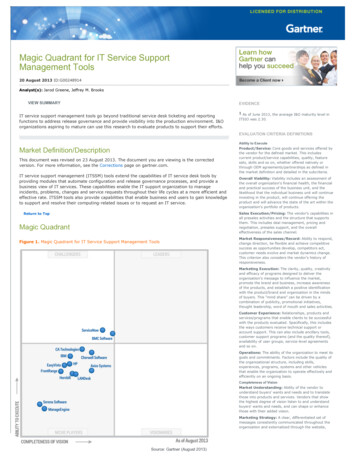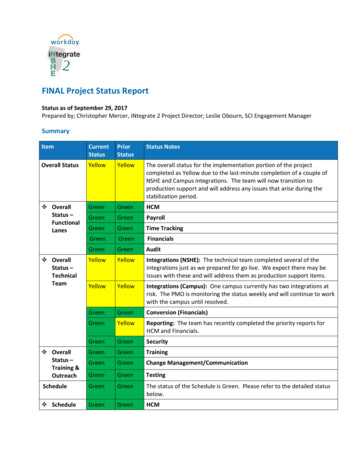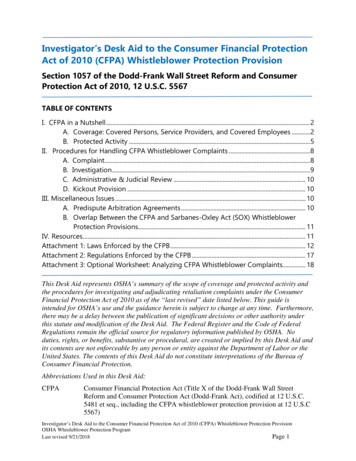
Transcription
Investigator’s Desk Aid to the Consumer Financial ProtectionAct of 2010 (CFPA) Whistleblower Protection ProvisionSection 1057 of the Dodd-Frank Wall Street Reform and ConsumerProtection Act of 2010, 12 U.S.C. 5567TABLE OF CONTENTSI. CFPA in a Nutshell .2A. Coverage: Covered Persons, Service Providers, and Covered Employees .2B. Protected Activity .5II. Procedures for Handling CFPA Whistleblower Complaints .8A. Complaint.8B. Investigation .9C. Administrative & Judicial Review . 10D. Kickout Provision . 10III. Miscellaneous Issues . 10A. Predispute Arbitration Agreements . 10B. Overlap Between the CFPA and Sarbanes-Oxley Act (SOX) WhistleblowerProtection Provisions. 11IV. Resources . 11Attachment 1: Laws Enforced by the CFPB . 12Attachment 2: Regulations Enforced by the CFPB . 17Attachment 3: Optional Worksheet: Analyzing CFPA Whistleblower Complaints. 18This Desk Aid represents OSHA’s summary of the scope of coverage and protected activity andthe procedures for investigating and adjudicating retaliation complaints under the ConsumerFinancial Protection Act of 2010 as of the “last revised” date listed below. This guide isintended for OSHA’s use and the guidance herein is subject to change at any time. Furthermore,there may be a delay between the publication of significant decisions or other authority underthis statute and modification of the Desk Aid. The Federal Register and the Code of FederalRegulations remain the official source for regulatory information published by OSHA. Noduties, rights, or benefits, substantive or procedural, are created or implied by this Desk Aid andits contents are not enforceable by any person or entity against the Department of Labor or theUnited States. The contents of this Desk Aid do not constitute interpretations of the Bureau ofConsumer Financial Protection.Abbreviations Used in this Desk Aid:CFPAConsumer Financial Protection Act (Title X of the Dodd-Frank Wall StreetReform and Consumer Protection Act (Dodd-Frank Act), codified at 12 U.S.C.5481 et seq., including the CFPA whistleblower protection provision at 12 U.S.C5567)Investigator’s Desk Aid to the Consumer Financial Protection Act of 2010 (CFPA) Whistleblower Protection ProvisionOSHA Whistleblower Protection ProgramPage 1Last revised 9/21/2018
CFPBOSHASECSOXConsumer Financial Protection BureauOccupational Safety and Health AdministrationSecurities and Exchange CommissionSarbanes-Oxley ActI. CFPA In A Nutshell:Under the CFPA whistleblower protection provision, no covered person or service provider maydischarge or otherwise retaliate against a covered employee or authorized representative forengaging in any protected activity. CFPA protects employees from retaliation for, among otherthings, making complaints about potential violations of any law, rule, order, standard, orprohibition under the CFPB’s jurisdiction.The CFPA whistleblower protection provision can be found at 12 U.S.C. 5567. The proceduresfor the investigation and resolution of CFPA whistleblower complaints can be found at 29 CFRPart 1985. Most of the definitions relevant to CFPA whistleblower complaints can be found at12 U.S.C. 5481 and 29 CFR 1985.101.A. Coverage: Covered Persons, Service Providers, and Covered EmployeesCFPA prohibits retaliation by any covered person. A covered person is a person thatengages in offering or providing a consumer financial product or service and certainaffiliates.CFPA also prohibits retaliation by any service provider. A service provider is a personthat provides a material service to a covered person in connection with the coveredperson’s offering or provision of a consumer financial product or service.CFPA protects covered employees and authorized representatives. A covered employeeis any individual performing tasks related to the offering or provision of a consumerfinancial product or service. Authorized representative is not defined.What is a consumer financial product or service?A consumer financial product or service is a financial product or service that is offered orprovided for use by consumers primarily for personal, family, or household purposes, and certainfinancial products or services delivered, offered, or provided in connection with a consumerfinancial product or service.Below is a simplified list of the consumer financial products and services defined in the statute,along with a non-exclusive list of examples of entities that may provide each product or service.If questions arise about whether a respondent is covered by CFPA, consult with the Directorateof Whistleblower Protection Programs, the Office of the Solicitor, or the CFPB:Investigator’s Desk Aid to the Consumer Financial Protection Act of 2010 (CFPA) Whistleblower Protection ProvisionOSHA Whistleblower Protection ProgramPage 2Last revised 9/21/2018
Extending credit and servicing loans, including acquiring, purchasing, selling,brokering, or other extensions of credit (other than solely extending commercial credit toa person who originates consumer credit transactions). Examples include banks andother loan originators, such as payday lenders, and may include other businesses such astax services or for-profit universities to the extent that they are involved in extending orservicing credit to consumers. Extending or brokering certain types of leases of personal or real property that are thefunctional equivalent of purchase finance arrangements. Examples include banks,secured lenders, issuers of auto leases 1 that result in the consumer having the right topurchase the car at the end of the lease, and “rent to own” companies (e.g., forfurniture). Note that typical apartment or house rentals that do not transfer ownership ofthe property to the lessee are not covered by this section. Providing real estate settlement services or performing appraisals of real estate orpersonal property. Examples include appraisal firms, mortgage brokers and servicers,and companies that provide real estate settlement services. Engaging in deposit-taking activities, transmitting or exchanging funds, or otherwiseacting as a custodian of funds or any financial instrument used by a consumer or for aconsumer. Examples include banks, credit unions, payday lenders, and remittanceservices. Selling, providing, or issuing stored value or payment instruments, such as prepaidcards or debit cards. Examples include banks and card issuers and some digital walletservices. Providing check cashing, check collection, or check guaranty services. Examplesinclude check-cashing operations. Providing payments or other financial data processing products or services to aconsumer by any technological means. Examples include banks and digital walletservices. Providing financial advisory services to consumers on individual financial matters orrelating to proprietary financial products or services, including providing creditcounseling to any consumer; and providing services to assist a consumer with debtmanagement or debt settlement, modifying credit terms, or avoiding foreclosure.Note that for purposes of CFPA, services related to securities provided by a personregulated by the Securities and Exchange Commission (SEC) or a state securitiescommission are not consumer financial products or services. Examples of coveredpersons that offer financial advisory services include banks, credit counseling services,and entities that provide credit counseling as part of their business.1See also 12 C.F.R. § 1001.2(a). If questions arise regarding whether a certain employer is covered under the CFPAwhistleblower provision because it is a motor vehicle dealer, please contact the Directorate of WhistleblowerProtection Programs or the Office of the Solicitor for further guidance.Investigator’s Desk Aid to the Consumer Financial Protection Act of 2010 (CFPA) Whistleblower Protection ProvisionOSHA Whistleblower Protection ProgramPage 3Last revised 9/21/2018
Collecting, analyzing, maintaining, or providing consumer report information or otheraccount information, including information relating to the credit history of consumers,used or expected to be used in connection with decisions regarding the offering orprovision of a consumer financial product or service. Examples include banks, creditreporting agencies, and lenders. Collecting debt related to consumer financial products or services. Examples includedebt collectors (whether or not subject to the Fair Debt Collection Practices Act). The CFPB also may identify additional financial products or services by regulation.What is not a consumer financial product or service?Under CFPA, a consumer financial product or service does not include: The business of insurance (Examples include writing life, home, health or autoinsurance policies), Electronic conduit services (Examples include a cloud service. The exclusion onlyapplies where CFPA’s technical definition of electronic conduit services in 12 U.S.C.5481(11) is met), or Commercial/business financial products or financial services. (CFPA coversconsumer financial products and services—i.e., financial products for use by consumersprimarily for personal, family, or household purposes. Products aimed atcommercial/business consumers are not covered. Examples include business loans).Investigator’s Desk Aid to the Consumer Financial Protection Act of 2010 (CFPA) Whistleblower Protection ProvisionOSHA Whistleblower Protection ProgramPage 4Last revised 9/21/2018
B. Protected ActivityProtected Activity:A covered employee is protected from retaliation under CFPA for having:1. Provided, caused to be provided, or being about to provide or cause to be provided tothe employer, the CFPB, or any other state, local, or federal government authority orlaw enforcement agency information relating to any violation or any conduct that theemployee reasonably believes is a violation of any provision of law (including theCFPA) that is subject to the jurisdiction of the CFPB, or any rule, order, standard, orprohibition prescribed by the CFPB;2. Testified or will testify in a proceeding concerning such violation;3. Filed, instituted, or caused to be filed or instituted, any proceeding under any Federalconsumer financial law; or4. Objected to, or refused to participate in, any activity, policy, practice, or assigned taskthat the employee reasonably believes violates any law, rule, order, standard, orprohibition subject to the jurisdiction of or enforceable by the CFPB.Complaints to whom?Complaints to an employer, the CFPB, and any other federal, state, or local government authorityor law enforcement agency may be protected. The employee’s complaint can take any form—itcan be in person, on the phone, in an email, etc.Complaints about what?Generally, an employee is protected from retaliation for providing information about, testifyingin a proceeding concerning, objecting to, or refusing to participate in any activity that is, or thatthe employee reasonably believes to be, a violation of CFPA or any other provision of lawsubject to the jurisdiction of, or enforceable by, the CFPB, or any rule, order, standard, orprohibition prescribed by the CFPB.Collectively, the laws implemented and enforced by the CFPB are generally referred to as the“Federal consumer financial laws.”2 They include CFPA (Title X of the Dodd-Frank Act), aswell as eighteen other enumerated consumer laws, other laws for which authorities transferred tothe CFPB under certain provisions of CFPA, and rules and orders prescribed by the CFPB underCFPA, the enumerated consumer laws, or authorities transferred. Attachment 1 describes eachof the laws enforced by the CFPB. Attachment 2 contains a non-exhaustive list of regulationsenforced or enforceable by the CFPB. The laws and regulations enforced by CFPB generally fall2See CFPA section 1002(14).Investigator’s Desk Aid to the Consumer Financial Protection Act of 2010 (CFPA) Whistleblower Protection ProvisionOSHA Whistleblower Protection ProgramPage 5Last revised 9/21/2018
into five buckets. Refer to Attachment 1 if the conduct at issue in the whistleblower complaintfalls into any of the five buckets.CFPA Protected Activity Generally Comes in Five Buckets:ProtectingAgainst Unfair,Deceptive, orAbusivePractices AgainstConsumersProtectingConsumerMortgages / RealEstateTransactionsProtectingConsumerCredit, Lending,Leasing,Borrowing, andSavingsProtecting thePrivacy ectronic FundTransfersThe statutes and regulations enforced by the CFPB share a common goal. Each seeks to protectconsumers of financial products and services from acts or practices that may harm them. TheCFPB has broad jurisdiction to promote fairness and transparency for mortgages, credit cards,loans, bank accounts, and other consumer financial products and services. Protected activityrelates to any violation of the laws mentioned above.Protection for complaints regarding unfair, deceptive, or abusive acts or practices:CFPA (Title X of the Dodd-Frank Act) prohibits covered persons and service providers fromengaging in unfair, deceptive, or abusive acts or practices (UDAAP) with respect to anyconsumer financial product or service. Reports of conduct that a covered employee reasonablybelieves is unfair, deceptive, or abusive are a prime example of protected activity under CFPA. An act or practice is unfair if the act or practice causes or is likely to cause substantialinjury to consumers, which is not reasonably avoidable by consumers, and which is notoutweighed by countervailing benefits to consumers or competition. A representation, omission, act, or practice is deceptive if it misleads or is likely tomislead the consumer; if the consumer’s interpretation of the representation, omission,act, or practice is reasonable under the circumstances; and if the representation, omission,act, or practice is material.Investigator’s Desk Aid to the Consumer Financial Protection Act of 2010 (CFPA) Whistleblower Protection ProvisionOSHA Whistleblower Protection ProgramPage 6Last revised 9/21/2018
A practice is abusive if it materially interferes with the ability of aconsumer to understand a term or condition of a consumer financialproduct or service or if it takes unreasonable advantage of: a lack ofunderstanding on the part of the consumer of the material risks,costs, or conditions of the product or service; the inability of theconsumer to protect his own interests in selecting or using theproduct or service; or the reasonable reliance by the consumer on acovered person or service provider to act in the interests of theconsumer.CFPA protects coveredemployees fromretaliation for reportingconduct they reasonablybelieve is unfair,deceptive, or abusiverelated to a consumerfinancial product orservice.More information about CFPA’s prohibition on unfair, deceptive, or abusiveacts or practices, as well as examples of conduct that the CFPB regards as violating theseprohibitions, can be found on the CFPB’s website, https://www.consumerfinance.gov/, includingin the CFPB’s Supervision and Examination Manual, updated June 2017, available ce/guidance/supervision-examinations/ andthe 2012 UDAAP examinations procedures chapter, which can be found gov/f/documents/102012 cfpb unfairdeceptive-abusive-acts-practices-udaaps procedures.pdfWhat is a reasonable belief that a violation has occurred?CFPA requires that a complaint be about a violation or something that the employee “reasonablybelieves” to be a violation of any law, rule, order, standard, or prohibition under the jurisdictionof or enforced by the CFPB. Courts and the Department of Labor’s Administrative ReviewBoard have held under the CFPA whistleblower provision and other OSHA-enforcedwhistleblower laws that to have a “reasonable belief,” an employee must have a subjective belief(i.e., actually believe that a violation has occurred, is occurring, or is likely to occur), and thebelief must be objectively reasonable (i.e., it must be possible that a reasonable person in theemployee’s position would share this belief).In determining whether these two requirements are met, courts and the Department of Labor’sAdministrative Review Board have held that the employee’s training, experience, andeducational background are relevant. The employee need not expressly refer to any law at all incommunicating concerns to the employer, regulatory agencies, or law enforcement. Relatedly,the employee also does not have to be correct that the information the employee provided relatesto an actual violation. The complainant will be protected so long as a reasonable person with thesame training and experience could believe that the relevant activity constitutes a violation. Areasonable but mistaken belief is protected.The following are examples of situations that could involve CFPA coverage and protectedactivity (but should not be read to suggest the conduct described could only violate the onespecific law referenced in each example): A branch manager at a bank that offers consumer loans complains to his district managerthat a loan officer under his supervision failed to provide a three-day right of rescissionon a consumer credit transaction and that standard procedures within the bank make itlikely that the three-day right of rescission has repeatedly not been provided to consumersInvestigator’s Desk Aid to the Consumer Financial Protection Act of 2010 (CFPA) Whistleblower Protection ProvisionOSHA Whistleblower Protection ProgramPage 7Last revised 9/21/2018
in violation of the Truth in Lending Act. The bank is a covered employer because itoffers consumer loans. The district manager is a covered employee because hesupervises the employees who provide those loans to consumers. The branch manager’scomplaint is protected as long as he reasonably believed the conduct violated the Truth inLending Act, one of the laws subject to the jurisdiction of the CFPB. A new manager at a bank is concerned about high numbers of new checking accountcustomers opting into unusually costly overdraft protection services. After reviewing theaccount application and promotional materials, he believes that those materials obscurethe fees and make the optional overdraft protection services seem mandatory for newcustomers. He reports his concerns to his supervisor. The bank is a covered employerbecause it is engaging in deposit-taking activities for consumers. The manager is acovered employee because he is supervising the employees who help consumers openchecking accounts. The manager’s complaint is protected as long as he reasonablybelieved that the conduct he reported was unfair, deceptive, or abusive to consumers inviolation of the CFPA, one of the laws subject to the jurisdiction of the CFPB. A customer service representative works for a company that issues credit cards toconsumers. It also offers convenience checks that customers can use for cash advancesagainst their credit cards. Customers can call the company to request checks. Theemployee’s supervisor says, “Don’t send any checks to customers who sound Black orHispanic on the phone.” The employee complains to the corporate ethics hotline that hisboss is denying services based on race and national origin. The company is a coveredemployer because it offers credit cards to consumers. The customer servicerepresentative is a covered employee because he fills orders for convenience checks tocustomers. The employee’s report to the corporate ethics hotline is protected because theemployee reported concerns that he reasonably believed violate the Equal CreditOpportunity Act, one of the laws subject to the jurisdiction of the CFPB.II. Procedures for Handling CFPA Whistleblower ComplaintsProcedures for handling CFPA whistleblower complaints are set forth in 29 C.F.R. Part 1985.Below is a summary of the procedural provisions most relevant to the OSHA investigation.More information is also available in the What to expect during an OSHA WhistleblowerInvestigation section of OSHA’s website, OSHA’s Filing Whistleblower Complaints under theConsumer Financial Protection Act fact sheet, and in the OSHA Whistleblower InvestigationsManual.A. ComplaintWho may file: An employee who believes that he or she has been retaliated against in violationof CFPA may file a complaint with OSHA. The employee may also have a representative file onthe employee’s behalf.Form: The complaint need not be in any particular form. Oral or written complaints areacceptable, including OSHA’s Online Complaint form. If the complainant cannot make acomplaint in English, OSHA will accept a complaint in any language.Investigator’s Desk Aid to the Consumer Financial Protection Act of 2010 (CFPA) Whistleblower Protection ProvisionOSHA Whistleblower Protection ProgramPage 8Last revised 9/21/2018
Timing: The complaint must be filed within 180 days of when the alleged adverse action tookplace or when the complainant learned of the adverse action. Equitable tolling principles mayextend the time for filing in limited circumstances, consistent with the guidance in OSHA’sWhistleblower Investigations Manual.Distribution of complaints and findings to partner agencies: Complaints and findings in CFPAcases should be sent to the CFPB and the DOJ Civil Frauds section. If the CFPA complaintallegations also involve protected activity under SOX, complaints and findings should also besent to the SEC. (See Section III B on pg. 11 for more information on the overlap between CFPAand SOX.)B.InvestigationUpon OSHA receiving a complaint, OSHA will evaluate the complaint to determine whether thecomplaint contains a prima facie allegation of retaliation. In other words, the complaint,supplemented as appropriate with interviews of the complainant, must allege that:1. The employee engaged in CFPA-protected activity;2. The respondent knew or suspected that the employee engaged in CFPA-protectedactivity;3. The employee suffered an adverse action; 3 and4. The circumstances were sufficient to raise the inference that the protected activitywas a contributing factor in the adverse action.If the complaint contains a prima facie allegation of retaliation, OSHA will ask for a positionstatement from the respondent and proceed with the investigation. If it does not, and thecomplainant does not agree to administrative closure of the complaint, OSHA will dismiss thecomplaint with notice to the complainant and the respondent of the right to request a hearingbefore a Department of Labor administrative law judge (ALJ).The CFPA whistleblower provision uses a “contributing factor” standard. Thus, following theinvestigation, OSHA will find that retaliation occurred if it determines that there is reasonablecause to believe that CFPA-protected activity was a contributing factor in the decision to takeadverse action against the complainant and the respondent has not shown by clear andconvincing evidence that it would have taken the same action in the absence of the protectedactivity. A contributing factor is a factor which, alone or with other factors, in any way affectsthe outcome of a decision.If OSHA finds reasonable cause to believe that retaliation occurred, it will issue findings and apreliminary order stating the relief to be provided. The relief may include reinstatement,backpay, compensatory damages, other remedies for the retaliation (such as a neutral reference),and reasonable attorney fees and costs.3Courts have held under analogous OSHA-enforced whistleblower protection laws that an adverse action is anaction that might dissuade a reasonable employee from engaging in protected activity. Examples of adverse actionsinclude (but are not limited to) firing, demoting, denying overtime or a promotion, or disciplining the employee.Investigator’s Desk Aid to the Consumer Financial Protection Act of 2010 (CFPA) Whistleblower Protection ProvisionOSHA Whistleblower Protection ProgramPage 9Last revised 9/21/2018
If OSHA does not find reasonable cause to believe that retaliation occurred, it will issue findingsdismissing the complaint.If the complainant and respondent agree to settle the case during the investigation, they mustsubmit the settlement agreement for OSHA’s review and approval.C.Administrative and Judicial ReviewEither the complainant or the respondent may object to OSHA’s findings within 30 days andrequest a hearing before an ALJ. Filing objections will stay OSHA’s order for all relief exceptreinstatement, which is not automatically stayed. If no objections are filed, OSHA’s findingsbecome the final order of the Secretary of Labor not subject to review.The ALJ proceeding is a de novo, adversarial proceeding in which both the complainant and therespondent have the opportunity to seek documents and information from each other in discoveryand to introduce evidence and testimony into the hearing record. OSHA does not typicallyparticipate in the ALJ proceeding. Documents and other information submitted to OSHA duringthe investigation do not automatically become part of the record in the ALJ proceeding.However, both the complainant and the respondent may introduce evidence that they obtained orused during OSHA’s investigation into the ALJ proceeding. The ALJ may hold a hearing ordismiss the case without a hearing if appropriate. Either the complainant or respondent mayappeal the ALJ’s decision in the case to the Department of Labor’s Administrative Review Board(ARB), which may either accept or reject the case for review. A complainant or respondent mayobtain review of an ARB decision or an ALJ decision which the ARB has declined to review bythe appropriate U.S. Court of Appeals.D.Kickout ProvisionCFPA permits a complainant to bring a de novo CFPA action in federal district court if theDepartment of Labor has not reached a final decision on the complainant’s CFPA claim within210 days of the filing of the complaint with OSHA and the delay is not due to the bad faith of thecomplainant, or within 90 days after receiving OSHA’s findings.III. Miscellaneous IssuesA. Predispute Arbitration AgreementsThe CFPA whistleblower provision generally prohibits the enforcement of predispute arbitrationagreements with respect to alleged violations of the provision, and such agreements cannot beused to waive any rights or remedies that the complainant has under the CFPA whistleblowerprovision. Therefore, an arbitration agreement that the complainant and respondent entered intobefore the adverse action (e.g., in the employment agreement between the complainant and therespondent or in the respondent’s employee handbook) cannot preclude OSHA frominvestigating a complainant’s CFPA claim.Investigator’s Desk Aid to the Consumer Financial Protection Act of 2010 (CFPA) Whistleblower Protection ProvisionOSHA Whistleblower Protection ProgramPage 10Last revised 9/21/2018
B. Overlap Between the CFPA and Sarbanes-Oxley Act (SOX) WhistleblowerProtection ProvisionsWhistleblower complaints filed under CFPA may also allege violations of the whistleblowerprotection provision of SOX, 18 U.S.C. 1514A. The SOX whistleblower protection provision,among other things, prohibits publicly traded companies and others from discharging orotherwise retaliating against an employee for reporting conduct that the employee reasonablybelieves constitutes mail, wire, bank, or securities fraud, a violation of any SEC rule orregulation, or a violation of a provision of federal law relating to fraud against shareholders. Formore information on SOX, see OSHA’s Filing Whistleblower Complaints Under the SarbanesOxley Act fact sheet and other resources available on OSHA’s website.IV. ResourcesThe CFPB’s website contains a wide variety of resources that may be helpful to OSHAinvestigators in evaluating whether the coverage and protected activity requirements of theCFPA whistleblower provision are met in a particular case. One helpful resource is the CFPB’sSupervision and Examination Manual, which is the CFPB’s guide for examiners to use inoverseeing certain banks, credit unions, and other companies that engage in offering or providingconsumer financial products or services. The manual describes how the CFPB supervises andexamines these companies and gives CFPB examiners direction on how to assess compliancewith federal consumer financial laws.Investigator’s Desk Aid to the Consumer Financial Protection Act of 2010 (CFPA) Whistleblower Protection ProvisionOSHA Whistleblower Protection ProgramPage 11Last revised 9/21/2018
Attachment 1: Laws Enforced by t
The CFPA whistleblower protection provision can be found at 12 U.S.C. 5567. The procedures for the investigation and resolution of CFPA whistleblower complaints can be found at 29 CFR Part 1985. Most of the definitions relevant to CFPA whistleblower complaints can be found at 12 U.S.C. 5481 and 29 CFR 1985.101.
